
The North West Shelf Venture is Australia’s largest hydrocarbons project, based on the Burrup Peninsula near Dampier in the Pilbara region of Western Australia.
The original participants of the venture were Woodside Energy, Shell Development (Australia), BHP Petroleum (North West Shelf), BP Developments Australia, Chevron Australia and Japan Australia LNG (MIMI), each ownowning an equal share. During 2008, Woodside Energy acquired Shell’s 16.67% stake in the project.
The venture incorporates an onshore plant producing gas for domestic consumption in Western Australia.
The plant also produces liquefied natural gas, liquefied petroleum gases and natural gas condensate.
More than seven million tonnes of liquid natural gas is shipped to long-term customers in Japan and spot buyers in Spain, Korea and the US.
North West Shelf Venture: phase I
The venture has been developed in various phases, the first of which is the domestic gas phase. This involved construction of one of the world’s largest capacity offshore gas production platforms, North Rankin A, which began operation in 1984.
With it, the Goodwyn A platform and the floating production vessel Cossack Pioneer extract gas, condensate and crude oil for export or processing over 130km away at the venture’s onshore plant located on the Burrup Peninsula.
North West Shelf Venture: phase II
The second phase of the project, the LNG phase, began in 1985. This involved the construction of two LNG processing trains and associated stabilisation and condensate storage facilities, each with the capacity to produce 2.2 million tonnes of LNG a year. Exports began in 1989.
North West Shelf Venture: phase III
The project’s third phase was completed in 1993 and involved the construction of a third LNG train and facilities to deal with the higher condensate and LPG content of the gas. This brought the plant’s total capacity up to 6.6 million tonnes of LNG per year.
This was closely followed by adding LPG (butane and propane) to the product mix. This expansion included the construction of a new load-out jetty for exporting LPG and condensate, and storage tanks for butane and propane.
North West Shelf Venture: phases IV and V
The project’s fourth phase commenced in 2001 with the construction of the fourth LNG processing train at the Karratha gas plant. The 4.4mtpa LNG train came onstream in 2004.
The plant train is integrated into the operations of the existing plant and shares some of the existing facilities, LNG storage and loading systems.
The new train is fully air-cooled and features high-efficiency gas turbine (aero-derivative) generators to augment existing power generation. An advanced nitrogen rejection system is provided to maximise LNG production. LNG from the train is exported via the loading jetty in Withnell Bay.
A 42in-diameter pipeline connecting the plant and the venture’s gas fields is also expected to be constructed.
The fifth phase of expansion began in August 2005. The fifth LNG train came onstream in 2008 and production capacity of the plant increased to 16.3 million tonnes.
Contract
The contract for engineering, procurement and construction management, worth about AUS$280m, was awarded to the Kellogg Joint Venture, which comprised Halliburton Australia (a Kellogg Brown & Root company), Hatch-Kaiser Engineers, Clough Engineering and JGC. The contract work was completed in 2004.
Project investment
The investment for the North West Shelf Venture project was around $1.6bn. The expansion project provides a major boost to Western Australian exports, with significant flow-on effects elsewhere in the economy.
About 9,000 direct and indirect jobs across Australia were created during the peak construction period.

